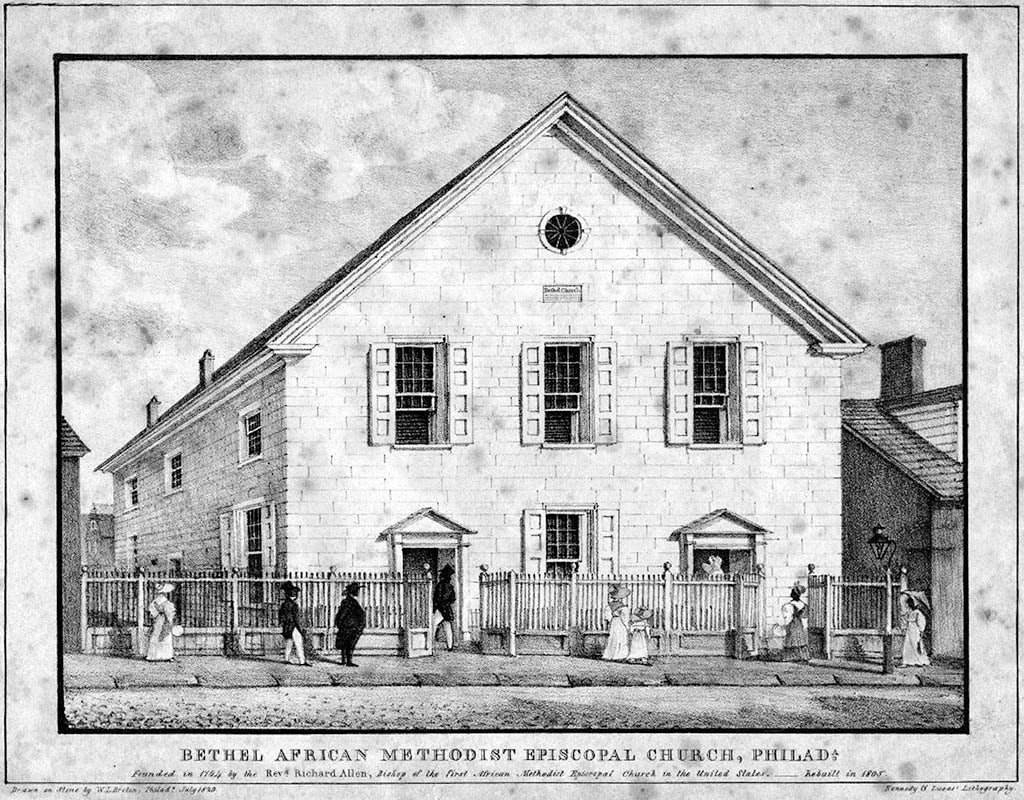We’re commemorating its founder, Richard Allen’s, birthday!
The African Methodist Episcopal (AME) Church was the first independent Black denomination in the United States. It’s one of the only denominations created not because of theological differences, but because of racial issues, Encyclopedia Britannica reports. Black people attending St. George’s Methodist Episcopal Church in Philadelphia were being forced to sit in the gallery, and after officials pulled those who were praying up off their knees, congregants Richard Allen, Absalom Jones, and others came together to form the Free African Society, a mutual aid organization, AME Church reports.
The organization focused on building its own Methodist church, Bethel AME in Philadelphia. In 1794, Allen, a formerly enslaved person in Delaware, was dedicated as pastor of Bethel by Methodist Bishop Francis Asbury. Allen then focused on establishing Bethel’s independence from other white Methodist churches, suing in the Pennsylvania courts in 1807 and 1815 for the AME’s independence from the MEC institution. In 1816, Allen was again consecrated as the new bishop of the newly formed AME denomination.
While the church still followed the doctrines of Methodist teaching, whose churches had primarily been established in the Northeast and Midwest, Allen and the original founders sought to gain membership in majority Black communities. They then established huge congregations in Philadelphia, New York, Boston, Pittsburgh, Baltimore, Washington, D.C., Cincinnati, Chicago, and Detroit, before branching out to slave states like Maryland, Kentucky, Missouri, and Louisiana. Membership in the South continued to increase and with the permission of Union army officials, many AME clergy members recruited newly freed slaves. A sermon from Theophilus G. Steward entitled, “I Seek My Brethren,” was often repeated as a call to evangelize Southern Black people and by 1880, the AME Church membership had reached 400,000 members.
Bishop Henry Turner then worked to spread the church internationally, pushing the AME church to Liberia and Sierra Leone in 1891 and then South Africa in 1896. The church also established HBCUs like Wilberforce University to help educate Black students, establishing the AME University in Liberia in 1995. Over the years, the church has continued to offer distinctive theology germane to the Black community, criticizing Euro-centric Christianity for its lack of addressing the plight of those who are oppressed across the globe through sound theology.
Today, the AME church is present in more than 20 Episcopal districts and 39 countries across 5 continents. There are 21 active bishops and 9 General Officers who manage the various departments of the church, and they boast more than 2 million members and 7,000 congregations across North America, the Caribbean, Africa, South America, and the United Kingdom. In 2000, the AME church elected its first woman bishop, Vashti Murphy McKenzie, and in 2012, the church restored its relationship with the United Methodist Church and a number of other African-American churches, including the African Methodist Episcopal Zion Church.
In honor of Allen’s contributions to the Black church legacy, let’s wish him a Happy Heavenly Birthday!
Here’s the history behind the AME church, the first independent Black denomination in the U.S./Mother Bethel AME Church, Philadelphia, July 1829/Illustration courtesy of William Breton/Library Company of Philadelphia


What a comprehensive history. Can I know more of its establishment in Sierra Leone? And its relationship with the late Rev Adamu John